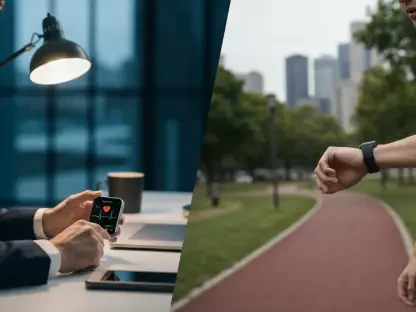Apple’s innovation-focused trajectory appeared poised to introduce significant enhancements to its smart home devices as developers delved into the nuances of iOS 26 Beta 4. Embedded within this update were early hints of a potential new HomePod—a model equipped with a touchscreen display. This revelation came alongside a setting that enabled information display such as local weather and time, functionality that existing HomePod models inherently lacked due to their absence of visual screens. The intrigue had roots in previous speculations circulating in the tech community regarding Apple developing a smart speaker featuring a 6 or 7-inch OLED display. This potential product, allegedly referred to by the codename J490, seemed to resonate with the direction Apple aimed to embrace—enhancing its smart speaker capabilities by integrating them with its suite of applications like Apple Music and HomeKit. Such developments were consistent with broader industry trends and Apple’s strategic pursuit of a robust smart home ecosystem solidifying user experiences and interactions.
Rumors and Speculations
Mark Gurman of Bloomberg, a notable voice well-regarded for accurate Apple forecasts, suggested that these rumblings were more than mere speculative whispers. The protracted timelines surrounding the alleged J490 model appeared to find their basis in not only technical challenges but also software synchronization. Complications arising from redesign elements within iOS 19 further compounded delays. Another dimension to this unfolding narrative was associated with Apple’s virtual assistant, Siri. Enhancements to Siri were widely seen as essential complements to the anticipated display functionality of the new HomePod model. Yet, advancements in Siri’s capabilities were reportedly pacing behind initial projections, contributing to the postponed development calendar. Despite these hurdles, Apple’s investment in the smart home sphere continued unabated, with the brand seeking to marry auditory and visual feedback within its product lines, charting a course whereby its smart home devices and services operated seamlessly, doubling down on user experience innovation despite emergent challenges.
Apple’s Vision for Smart Homes
Apple’s commitment to refining smart home experiences was evident in its methodical approach that blended hardware and software harmoniously. Leveraging a touchscreen HomePod as a hub could enhance interactions with Apple Music, HomeKit, and potentially other applications, establishing a cohesive user interface that addresses user demand for intuitive visual input and control. Such integration extended the possibilities of immersive interactions, providing sensory augmentation beyond voice-activated responses, a realm Apple thrived in capturing. The focus lay not merely on producing cutting-edge hardware but on the ecosystem that binds these devices—a vision aligning with strategies observed in other tech giants keen to champion the future of connected homes. Apple’s journey towards creating a more unified user experience underscored the competitive landscape, where multi-modal interaction met consumer expectations. As technological paradigms evolved, the pursuit remained relentless, with Apple seeking to cement its stature not just as a tech leader but as a transformative force within the smart home domain.
Future Possibilities and Challenges
The roadmap unfolding for Apple in this arena had its sights set towards expounding on the latent potential of smart devices. However, inherent in these innovations were challenges tethered to synchronization, both internal, concerning cross-functional team deliverables, and external, reflecting market adaptability. The prospect of touchscreen-enabled HomePods held exciting implications for those invested in enriched smart ecosystems, yet Apple’s path ahead called for leveraging robust design practices to circumvent misalignment risks. For consumers and industry insiders alike, the implanted teaser within iOS 26 ignited anticipation for stepwise integration advances. It subtly signaled Apple’s intent to push boundaries familiarizing the globe to a novel interaction ethos. This directional pursuit highlighted Apple’s enduring quest for excellence amidst technical, strategic, and market-driven elements shaping their product aspirations. Apple crafted avenues ushering enhanced interactivity through commitment to peak innovation facing a technology-rich future within the vibrant smart home oracle.
Reflecting on Apple’s Strategy
As Apple continues its journey of innovation, iOS 26 Beta 4 has unveiled potential advancements in its smart home devices. Within this update are early indications of a new HomePod model, which may feature a touchscreen display. This potential addition could allow it to display information like local weather and time, functionalities not possible with current HomePod models due to their lack of screens. This intrigue builds on ongoing rumors in the tech community about Apple crafting a smart speaker with a 6 or 7-inch OLED display, allegedly codenamed J490. This speculative product aligns with Apple’s strategic focus on enhancing its smart speaker lineup, aiming to integrate it more fully with apps like Apple Music and HomeKit. Such advancements follow broader industry trends, signaling Apple’s intent to fortify its smart home ecosystem. By unifying these capabilities, Apple aims to enrich user experiences and interactions, ensuring a seamless integration of its smart home technologies into everyday life.









